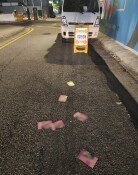[Analysis] Speculation Rampant Over Cause of Naval Fiasco
[Analysis] Speculation Rampant Over Cause of Naval Fiasco
Posted March. 29, 2010 07:55,
The government has yet to present a clear-cut explanation on how the naval patrol boat Cheonan sank Friday evening or countermeasures.
Worse, surviving crew members have given differing statements about the incident, fueling suspicion over the disaster.
① Vessel split into two? External attack suspected
Until soon after the accident, an explosion of unknown cause reportedly created a hole in the bottom of the Cheonans hull. The vessel sank three hours later at 12:30 a.m. Saturday.
Cheonan Captain Choi Won-il told a briefing for the families of the 46 crew members who went missing Saturday, One second after the explosion, the ship split into two, tipped over vertically, and sank in a matter of seconds.
After hearing the bang from the explosion, I went out to the captains room and saw the stern disappear.
When the families of the missing crew said, That statement is nonsense, Choi replied, I was wrong to say one second, but the ship sank instantly. I saw it with my own eyes.
Chois comments, however, seem to contradict those made in the initial briefing on the incident by the Joint Chiefs of Staff, which said the vessel started to sink after a hole was created in the hull.
Defense Minister Kim Tae-young also said Saturday, The vessel seems to have split into two, adding, When we checked (the ships condition) with a thermal observation device, the ship looked (as if it had split in two).
In contrast, a naval command official who accompanied the missing crews families to waters near Baengnyeong Island, where the Cheonan sank, reportedly said yesterday, The Cheonans captain reportedly said the vessel split into two instantly, but I cannot understand that in light of common sense.
Experts say that if a 1,200 ton-class patrol boat was split into two, chances are low that it was caused by an internal explosion. The government said an external attack is highly unlikely to have caused the incident, but experts say such massive damage is impossible unless caused by a torpedo or a floating mine in view of Chois testimony.
Ahn Byeong-gu, a director at Daewoo Shipbuilding & Marine Engineering and a retired commodore, said, Ammunition depots are situated at the stern section, but since explosives and detonators are kept separately, an explosion powerful enough to split the vessel into two is highly unlikely unless someone intentionally set off all of the explosives at once.
Another expert added, The possibility of a fire in the engine room and an explosion in a steamer or fuel tanker is low. Even if there is, it will hardly be powerful enough to tear the ship apart.
Several of the survivors say they did not hear an explosion.
② Can a 1,200-ton vessel sink in 20 minutes?
The Joint Chiefs of Staff said Saturday, Some 60 percent of the vessel submerged at around 9:30 p.m. Friday, some 20 minutes after a powerful explosion occurred in the stern. Skepticism is rising over the claim, however, that a 1,200-class patrol boat extending 88 meters sank so fast.
A patrol boat has more than 100 individual rooms designed to maximize survival chances, and the rooms are shut off in case of an accident. Hence, critics doubt whether the Cheonan lost its functions just 20 minutes after the accident.
Another expert said, All hatches must shut when the ship is on battle alert, but many hatches remain open in peacetime or if the ship is on a patrol mission. If seawater floods in due to a powerful explosion, the crew might have no time to shut the hatches of individual rooms.
Water might have flooded in because the function to shut individual rooms was crippled due to the explosion, other analysts say.
③ What did the Navy do for 70 minutes before the Coast Guard arrived?
According to the Joint Chiefs of Staff, Captain Choi informed the inland naval base of the accident by mobile phone after the engine stopped and power went out due to the explosion, interrupting radio communication.
Accordingly, the Navy deployed four speedboats to Baengnyeong Island at 9:41 pm, and the four ships arrived at the site at 9:58 p.m.
The speedboats failed, however, to rescue any of the crew members until 10:40 p.m. Instead, Coast Guard vessels saved 58 crew members from the sunken naval vessel. Had the speedboats taken the proper action in time, they might have saved most of the crewmen, experts say.
The Joint Chiefs of Staff said, The small speedboats could not approach the patrol boat and conduct rescue operations due to high waves of three meters high.
After the accident, the Joint Chiefs of Staff set the time of the accident at 9:45 p.m., or about 15 minutes later than the real time. The military corrected the time to 9:30 p.m. at a meeting of the parliamentary national defense committee Saturday.
A Joint Chiefs of Staff source said, This will sound like an excuse, but it was a mistake made due to the pressing situation.
④ Why was the Cheonan near Baengnyeong Island?
Questions are also being raised over why the Cheonan was near Baengnyeong Island. The site is only 1.8 kilometers southwest of the island in the Yellow Sea and water depth is only 24 meters.
A Joint Chiefs of Staff source said, The accident site is within the scope of the Cheonans operation, adding, It is not an area the ship commonly navigates, but is also not a site where it never visits, either.
The ship navigates in deeper areas in normal times, but operates in a shallow area to patrol the waters there, or because it can naturally hide itself in such an area, the source added. We had no reports of reefs.
⑤ Why could not sailors escape quickly?
Questions are being raised over why the 46 missing crew of the Cheonan could not escape when it was sinking.
Captain Choi said, I was reviewing the operations plan at the captains office after night shift.
One survivor said, I was eating a snack around 9 p.m. When I groped the wall in the dark and went outside (after the accident), I found the ship was tilting.
Other say the crew was not well trained to escape the vessel in case of emergency. Ruling Grand National Party lawmaker Kim Ok-lee said in a report to the National Assemblys national defense committee, Some sailors heard about (the explosion) but others did not. Doesnt this show a problem with emergency procedures?
Fellow ruling party lawmaker Lee Yoon-sung said, After the siren rings, the captain and sailors can generally talk on the phone, but there was apparently a problem with the command and emergency response system.
On how the officers survived, a military source said, This is because the command, bridge, and the combat situation room are located at the head of the patrol ship. The explosion occurred in the rear, where rank and file sailors were staying. If the head of the Cheonan was hit by a missile, officers would have been killed.
⑥ Where is the stern?
The stern of the Cheonan, where the missing people are suspected to be, remains missing. The Navy said, Since the stern of the patrol ship has a machine room, it immediately sank at the site of the accident, and the relatively light head of the Cheonan was carried away by the currents and sank to 7.2 kilometers away from the spot of the accident.
The head of the Cheonan was found, but not the stern. A source from the Navy headquarters who visited the site is known to have said, It seems impossible that the head of the patrol ship moved 7.2 kilometers from the spot of the accident in just over a day.
zeitung@donga.com rews@donga.com





![반찬통 착색 고민 끝…‘두부용기’ 버리지 말고 이렇게 쓰세요 [알쓸톡]](https://dimg.donga.com/c/138/175/90/1/wps/NEWS/IMAGE/2026/01/09/133126593.3.png)

